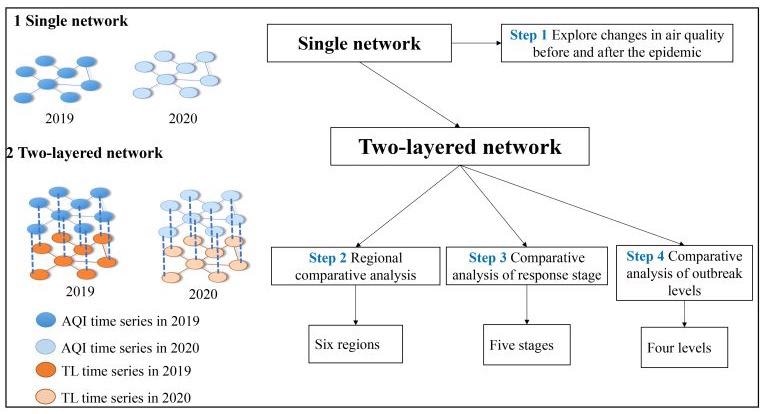Reviewed by Alex SmithApr 27 2022
Huge shifts in how people travel were created as a result of the COVID-19 pandemic. In certain regions, such limitations on travel have had little impact on air pollution, and few cities exhibit worse air quality than ever before.
 The two-layer network-based framework used for modeling air pollution between cities. Image Credit: Weiping Wang.
The two-layer network-based framework used for modeling air pollution between cities. Image Credit: Weiping Wang.
Chinese scientists made a network model that has been withdrawn from the air quality index and traffic index of 21 cities throughout six regions in their country to measure how traffic emissions from one city impacted another. The study was published in the journal Chaos, by AIP Publishing.
The researchers aimed to leverage data collected from COVID-19 lockdown procedures to better describe the relationship between air pollution and traffic and took the COVID-19 lockdowns as a unique opportunity for research.
Air pollution is a typical ‘commons governance’ issue. The impact of the pandemic has led cities to implement different traffic restriction policies, one after another, which naturally forms a controlled experiment to reveal their relationship.
Jingfang Fan, Study Author, Beijing Normal University
For such questions to be addressed, the researchers turned to a weighted climate network framework to model every city as a node with the help of pre-pandemic data gathered from 2019 and data from 2020. A two-layer network was added that helped incorporate lockdown stages, various regions and outbreak levels.
The traffic conditions that were encircled impacted air quality in Beijing – Tianjin – Hebei, central China, and the Chengdu–Chongqing Economic Circle following the explosion. Pollution peaked in cities as they made initial progress for containing the virus.
At this time, pollution in Beijing–Tianjin–Hebei, and central China reduced over time. But Beijing–Tianjin–Hebei noted one more spike as control measures for outward traffic from Wuhan and Hubei were lifted.
Air pollution in big cities, such as Beijing and Shanghai, is more affected by other cities. This is contrary to what we generally think, that air pollution in big cities is mainly caused by its own conditions, including the traffic congestion.
Saini Yang, Study Author, Beijing Normal University
The author of the study, Weiping Wang believes that the team’s work was of great inspiration to other interdisciplinary groups to help explore special methods to analyze the issues in environmental science. They will look to enhance their model with a greater degree of detail for traffic emissions.
Our discovery is that in order to improve air pollution, it is not only necessary to improve and reduce our own urban traffic and increase green travel, but also need the joint efforts of surrounding cities. Everyone is important in the governance of commons.
Na Ying, Study Author, Chinese Research Academy of Environmental Sciences
Journal Reference:
Wang, W., et al. (2022) Network approach reveals the spatiotemporal influence of traffic on air pollution under COVID-19. Chaos. doi.org/10.1063/5.0087844.